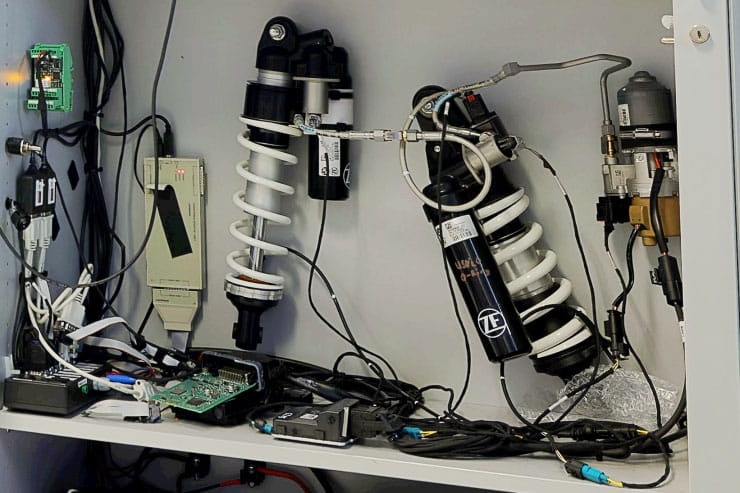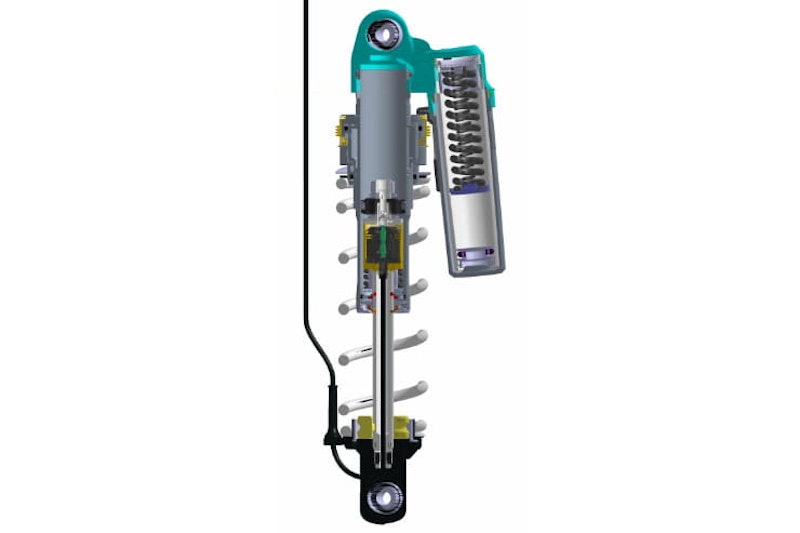For the past 20 years electronic motorcycle suspension has grown exponentially in sophistication, adaptability and technical complexity– and yet BMW is on the cusp of introducing a new system that might just make everything else look somewhat old-fashioned. They’re calling this next-generation electronic suspension ‘SAF Next’, and it’s looking increasingly certain to make its debut on the R1300GS. Here’s why it’s likely to become the most advanced and versatile suspension setup ever fitted to a road bike and, more interestingly, the secrets behind how it works…
What’s new about BMW’s next-generation suspension?
What makes SAF Next so clever is the addition of two completely new features: first, the ability for a shock to alter its spring rate (and take just 0.1 seconds to do it); and second, for a bike to automatically reduce its seat height at low speed to help a rider get their feet down. These two functions are completely independent – ie the system for changing spring stiffness is completely separate from the system that changes seat height – and they’re both in addition to all the existing cleverness you’ll already find on BMW’s Dynamic ESA, such as semi-active damping and automatic preload compensation.
How does the system change its spring rate?
On a regular shock, even a clever one with semi-active damping, the spring rate is pretty much fixed. How far a shock compresses when a certain force is applied is determined by the rate of the main spring that’s fitted – typically measured in N/mm, or how many Newtons of force it takes to compress the spring one millimetre in length. The higher the N/mm, the stiffer the spring.
But BMW’s new SAF Next system has the ability to swap between two spring rates, pretty much in real time. It can do this thanks to having an additional spring hidden inside the shock’s elongated piggyback chamber. In fact there’s actually two additional springs (one tucked inside the other to make for a more compact design) loading a separating piston, which in turn is connected to the shock’s oil circuit via a switching valve. If that read like a bit of a nerdy word salad, don’t worry – there’s a simple version.
With the switching valve shut, these additional springs are kept completely isolated and play no part in the shock’s behaviour. But when the switching valve is opened electronically (which takes just 0.1 seconds) oil pressure from the shock now pushes on the separating piston, and in turn these extra springs, making for a firmer overall spring rate. How much stiffer it gets depends on the rate of the additional springs, as well as the hydraulic ratio between the main shock’s piston rod and the piggyback chamber’s separating piston. This lets BMW pick the parts to tweak the setup so it behaves exactly how they want. But to give some sense of scale BMW say you could have, for example, a 140N/mm spring as standard, then stiffen it up to 170N/mm in a split-second. That’s a 20% difference, which you’d expect any rider to notice.
What’s the benefit of having two spring rates?
The perfect spring rate for a shock depends on a number of variables, including the weight of the bike, the rider, whether a pillion or luggage is being carried, the kind of roads being ridden on and the way the bike is being ridden. Until now, manufacturers have to pick one spring rate that does the best job across the full spectrum of likely use cases. It is, fundamentally, a compromise.
Semi-active damping and automatic preload systems are hugely helpful in that they can modify some of the suspension’s movement, as well as help maintain the bike’s ideal attitude and front-to-rear balance, but the spring rate itself is still fixed. Being able to pick between two spring rates allows BMW to build a suspension system that can perform better however it’s being used – you can have the improved ride quality from a softer spring one second, then the more taut behaviour of a stiffer spring a fraction of a second later. BMW say the switching valve works so fast, they can even change spring rate between suspension strokes – so it could compress with one spring rate, and rebound with another. The possibilities are enormous.
How does SAF Next help me put my feet down?
Seat height can be a real obstacle, sometimes literally, for shorter or less confident riders – especially when it comes to adventure bikes (cough, R1300GS, cough). A dual-purpose machine needs to ride high on long-legged suspension to clatter comfortably over off-road terrain, but a tall seat can put off customers in the showroom. BMW have offered specially adapted Low Seat Height versions of their bikes, but they’ll also admit that lowering a bike from its optimum stance compromises ground clearance and affects riding dynamics. The solution is automatic ride height adjustment – the second of SAF Next’s big party pieces.
They’re not the first to think along these lines. Harley-Davidson got there first a couple of years ago with their Pan America’s “Adaptive Ride Height” technology. However, BMW’s version has the potential to be a more sophisticated solution.
As you’d expect, BMW controls the bike’s ride height using the hydraulic preload adjusters on top of each shock. Of which there are two – one at the front, one at the back, which tells you the system will debut on a bike with Telelever. By plumbing both preload adjusters together, with a switching valve between them, BMW can use a single electric pump to adjust each shock’s preload individually. The result, they say, is a system that responds fast enough to fully lower – reducing seat height by 30mm – in less than one second. Lifting the bike back up again takes slightly longer (the rear shock is extended first, then the front after) but the whole process is completed in less than three seconds.
What if I don’t want it to lower the seat height for me?
At this stage BMW are merely demonstrating the technology – they’re not being drawn on the specifics of how it will be applied on whichever bike it appears first. But they’ll readily admit that there are some scenarios where a rider may want ride height adjustment to be applied automatically, and somewhere manual control would be preferred. So both auto and manual modes are possible – or they could be combined with and integrated into the bike’s riding modes.
The basic idea of an automatic system would be to make it speed-sensitive: the bike drops to a low position when riding slowly through towns and villages, improving manageability; then it lifts back up to its optimum, load-dependent height once you accelerate past a certain speed. However, in an off-road setting (hmm… now which bikes from BMW’s range might go off-road…) the decision between high and low ride heights comes down to the relative merits of ground clearance versus secure footing. And that’ll depend on individual rider skill and terrain.
While the fine details aren’t confirmed, it would seem a pretty safe bet that a rider who doesn’t want a GS (or, err, whichever new BMW it turns out to be) to lower its seat height will be able to turn the system off, or fix it in one place. But, much more importantly, having ride height adjustment integrated into SAF Next suspension would appear to make for a much less-compromised solution than the existing Low Seat Height models, giving confidence to shorter or less experienced riders and helping to make, say, a flagship adventure bike more accessible to more riders than ever before.
If you’d like to chat about this article or anything else biking related, join us and thousands of other riders at the Bennetts BikeSocial Facebook page.

